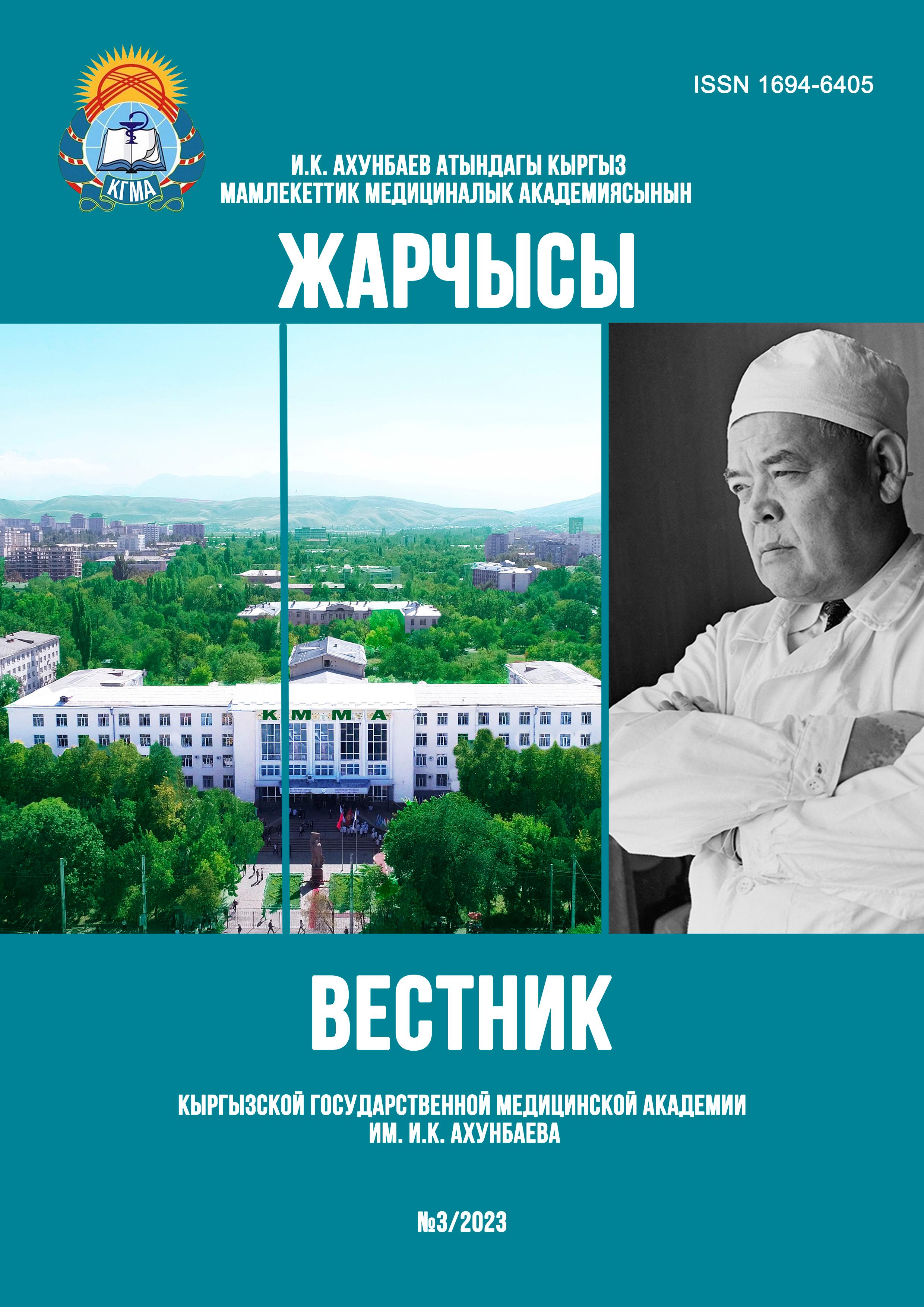COMPARATIVE STUDY OF NEPHROPROTECTIVE ACTIVITY OF SODIUM FUMARATE, MANNITOL AND FUROSEMIDE ON AN EXPERIMENTAL MODEL OF THERMAL RENAL ISCHEMIA
DOI:
https://doi.org/10.54890/1694-6405_2023_3_86Abstract
While performing surgical treatment of the localized form of renal cell cancer by means of open or laparoscopic kidney resection, renal warm ischemia (RWI) is becoming the necessary aspect of the intervention. Using RWI allows to prevent parenchymal bleeding, to optimize operative conditions, to increase significantly the efficiency of hemostasis. However, an important problem is the probability of ischemic hypoxic damage of the secured part of the kidney tissue during RWI and renal functional impairment in the postoperative period.
Aim of the study – comparative study of nephroprotective activity of sodium fumarate, mannitole and furosemide using experimental model of 30- and 60-minute renal warm ischemia in rabbits.
Materials and methods. The experiments were carried out on 360 conventional male-rabbits of the “Chinchilla” breed weighed 2,6±0,3 kg which were allocated into 10 groups. The control group №1 included intact animals, the control group №2 included the rabbits that were operated without clamping the renal artery. For the animals from the trial groups (№3-№10) the experimental model of 30- and 60-minute RWI was developed. In groups №3 and №4 medication was not provided. Other rabbits endured renal warm exsanguination against the background of sodium fumarate (groups №5 and №6 - 1,5 ml/kg IV), lasix (groups №7 and №8 - 3,0 mg/kg IV) and mannitole (№9 and №10 -1,0 g/kg IV). The influence of RWI on the renal tissue ultrastructure and the levels of NGAL, Cystatin-C and creatinine in blood and urine were studied.
Results. Experimental pharmacologically non-corrected 30-minute RWI in trial animals induced swelling and edema of the final part of microvilli of the proximal tubules epithelium, increase of lysosome number in the hyaloplasm of epithelial cells, appearance of flaky content of medium electronic density in the lumens of distal tubules and collecting tubes, as well as sharp peak-like increase of NGAL and cystatin-C in blood and urine. Increasing the time of exsanguination up to 60 minutes was accompanied by the growth of severity and range of the observed disorder. In groups where sodium fumarate, lasix and mannitole were used the observed ultrastructural disturbances were expressed to lesser extent, whereas sodium fumarate demonstrated the best nephroprotective activity. In case of using mannitole the intensity of the observed disturbances was less than in the groups where mannitole, lasix or sodium fumarate were not provided. Lasix and sodium salt of fumaric acid showed a higher nephroprotective activity. The best results were received in the animals protected by sodium fumarate.
Conclusions. The studied medications provided a nephroprotective effect regarding renal ischemia of rabbits, sodium fumarate in the greatest degree, furosemide – less and mannitole – the least. Use of sodium fumarate allows to protect and stimulate the kidney tissue maximum effectively during oxygen deprivation of the ischemized organ.
Keywords:
renal warm ischemia, kidney resection, ischemic hypoxic damage, pharmacological nephroprotection, antihypoxants, sodium fumarate.References
1. Kuru TH, Zhu J, Popeneciu IV, Rudhardt NS, Hadaschik BA, Teber D, Roethke M. Volumetry may predict early renal function after nephron sparing surgery in solitary kidney patients. Springer plus. 2014;3:488. https://doi.org/10.1186/2193-1801-3-488
2. Mir M.C. Current Paradigm for Ischemia in Kidney Surgery. J. Urol. 2016;195(6):1655-1663.
3. Каприн А.Д., Старинский В.В., Петрова Г.В. Состояние онкологической помощи населению России в 2017 году. - Москва: МНИОИ им. П.А. Герцена; 2018. 236 с.
4. Данилов А.А., Дырдик М.Б., Березин К.В. Результаты дапароскопических вмешательств у больных с опухолями почки. Медицинский альманах. 2012;4(23):49-51.
5. Тимербулатов Ш. В., Тимербулатов М. В., Султанбаев А. У. Реперфузионный синдром в абдоминальной хирургии. Медицинский вестник Башкортостана. 2010;4:145-149.
6. Paugam-Burtz C, Wendon J, Belghiti J, Mantz J. Case scenario: Postoperative liver failure after liver resection in a cirrhotic patient. Anesthesiology. 2012;116:705-711. https://doi.org/10.1097/ALN.0b013e318247227b
7. Матвеев Б.П. Опухоли почечной паренхимы.В кн.: Б.П. Матвеева, ред. Клиническая онкоурология. М.: АБВ-пресс, 2011:11– 225.
8. Шунькина Г.Л. Роль биохимических исследований в оценке повреждения функции почек новорожденных после перенесенной гипоксии. Современные технологии в медицине. 2010;4:104-406.
9. Дряженков И.Г. Комлев Д.Л., Лось М.С. Факторы ишемического повреждения почки при ее резекции. Клиническая медицина. 2013;6:21-24.
10. Комяков Б.К., Замятнин С.А., Новиков А.И., Курков А.С., Попов С.В., Товстуха Д.В. и др. Экстракорпоральная резекция почки по поводу опухоли. Урология. 2013;4:60–63.
11. Pamer EC. Immune responses to commencal and environmental microbes. Nat. Immunol. 2007;8(11):1173-1178. https://doi.org/10.1038/ni1526
12. Humphreys BD, Czerniak S, DiRocco DP, Hasnain W, Cheema R, Bonventre JV. Repair of injured proximal tubule does not involve specialized progenitors. Proc. Natl. Acad. Sci. U.S.A. 2011;108 (22):9226-9231. https://doi.org/10.1073/pnas.1100629108
13. Jiang M, Wei Q, Dong G, Komatsu M, Su Y, Dong Z. Autophagy in proximal tubules protects against acute kidney injury. Kidney Int. 2012;82(12):1271-1283. https://doi.org/10.1038/ki.2012.261
14. Серегин А.В., Шустицкий Н.А. Органосохраняющая тактика при раке почки: учебное пособие. М.: ГБОУ ДПО РМАПО; 2013. 36 с.
15. Patel AR, Eggener SE. Warm ischemia less than 30 minutes is not necessarily safe during partial nephrectomy: every minute matters. Urol. Oncol. 2011;29(6):826-828. https://doi.org/10.1016/j.urolonc.2011.02.015
16. Thompson R, Lane BR, Lohse CM, Leibovich BC, Fergany A, Frank I et al. Every minute counts when the renal hilum is clamped during partial nephrectomy. Eur. Urol. 2010;58:340-345. https://doi.org/10.1016/j.eururo.2010.05.047
17. Thompson RH, Lane BR, Lohse CM, Leibovich BC, Fergany A, Frank I et al. Renal function after partial nephrectomy: effect of warm ischemia relative to quantity and quality of preserved kidney. Urology. 2012;79(2):356-360. https://doi.org/10.1016/j.urology.2011.10.031
18. Eckle T, Faigle M, Grenz A, Laucher S. A2B adenosine receptor dampens hypoxia-induced vascular leak. Blood. 2008;111(4):2024-2035. https://doi.org/10.1182/blood-2007-10-117044
19. Jia C. Advances in the regulation of liver regeneration. Expert Rev. Gastroenterol. Hepatol. 2011;5(1):105-121. https://doi.org/10.1586/egh.10.87
20. Kalogeris T, Baines CP, Krenz M, Korthuis RJ. Cell biology of ischemia/reperfusion injury. Int. Rev. Cell Mol. Biol. 2012;298:229-317. https://doi.org/10.1016/B978-0-12-394309-5.00006-7
21. Fulop A, Turóczi Z, Garbaisz D, Harsányi L, Szijártó A. Experimental models of hemorrhagic shock: a review. Eur. Surg. Res. 2013;50(2):57-70. https://doi.org/10.1159/000348808
22. Wen D. Inhibitor of DNA Binding 1 Is Induced during Kidney Ischemia Reperfusion and Is Critical for the Induction of Hypoxia-Inducible Factor-1α. Biomed Res. Int. 2016;46:343-386.
23. Zhang Z. Unilateral Partial Nephrectomy with Warm Ischemia Resultsi n Acute Hypoxia Inducible Factor 1-Alpha (HIF-1α) and Toll-Like Receptor 4 (TLR4) Overexpressionina Porcine Model. PLOS One. 2016;11(5):154.
24. Кирпатовский В.И., Надточий О.Н., Сыромятникова Е.В. Возможности пролонгации допустимых сроков ишемии почки при использовании различных вариантов противоишемической защиты. Вестник реабилитации органов и тканей. 2014;1:3-7.
25. Грицкевич А.А. Ильин С.А., Тимина И.Е., Зотиков А.Е., Кармазановский Г.Г., Теплов А.А. и др. Резекция почки ex vivo в условиях фармако-холодовой ишемии без пересечения мочеточника с ортотопической реплантацией сосудов при почечно-клеточном раке. Вестник урологии. – 2015;3:3-33. https://doi.org/10.21886/2308-6424-2015-0-3-3-33







